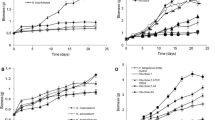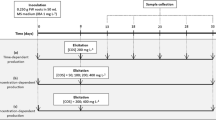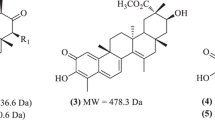Abstract
Hypericum perforatum is a well-known medicinal plant which contains a wide variety of metabolites, including xanthones, which have a wide range of biological properties, including antifungal activity. In the present study, we evaluated the capability of roots regenerated from calli of H. perforatum subsp. angustifolium to produce xanthones. Root biomass was positively correlated with the indole-3-butyric acid concentration, whereas a concentration of 1 mg l−1 was the most suitable for the development of roots. High auxin concentrations also inhibited xanthone accumulation. Xanthones were produced in large amounts, with a very stable trend throughout the culture period. When the roots were treated with chitosan, the xanthone content dramatically increased, peaking after 7 days. Chitosan also induced a release of these metabolites into the culture. The maximum accumulation (14.26 ± 0.62 mg g−1 dry weight [DW]) and release (2.64 ± 0.13 mg g−1 DW) of xanthones were recorded 7 days after treatment. The most represented xanthones were isolated, purified, and spectroscopically characterized. Antifungal activity of the total root extracts was tested against a broad panel of human fungal pathogen strains (30 Candida species, 12 Cryptococcus neoformans, and 16 dermatophytes); this activity significantly increased when using chitosan. Extracts obtained after 7 days of chitosan treatment showed high antifungal activity (mean minimum inhibitory concentration of 83.4, 39.1, and 114 μg ml−1 against Candida spp., C. neoformans, and dermatophytes, respectively). Our results suggest that root cultures can be considered as a potential tool for large-scale production of extracts with stable quantities of xanthones.



Similar content being viewed by others
References
Chan LK, Dewi PR, Boey PL (2005) Effect of plant growth regulators on regeneration of plantlets from bud cultures of Cymbopogon nardus L. and the detection of essential oils from the in vitro plantlets. J Plant Biol 48:142–145. doi:https://doi.org/10.1007/BF03030574
CLSI (2008a) Reference method for broth dilution antifungal susceptibility testing of yeasts; approved standard—third edition. CLSI document M27A3. Clinical and Laboratory Standards Institute, Wayne
CLSI (2008b) Reference method for broth dilution antifungal susceptibility testing of filamentous fungi; approved standard—second edition. CLSI document M38-A2. Clinical and Laboratory Standards Institute, Wayne
CLSI (2008c) Reference method for broth dilution antifungal susceptibility testing of yeasts; third informational supplement. CLSI document M27-S3. Clinical and Laboratory Standards Institute, Wayne
Cui XH, Chakrabarty D, Lee AJ, Paek KY (2010) Production of adventitious roots and secondary metabolites by Hypericum perforatum L. in a bioreactor. Bioresour Technol 101:4708–4716. doi:https://doi.org/10.1016/j.biortech.2010.01.115
Dias ACP, Seabra RM, Andrade PB, Fernandes-Ferreira M (1999) The development and evaluation of an HPLC-DAD method for the analysis of the phenolic fractions from in vivo and in vitro biomass of Hypericum species. J Liq Chromatogr Relat Technol 22:215–227. doi:https://doi.org/10.1081/JLC-100101655
Dörnenburg H, Knorr D (1995) Strategies for the improvement of secondary metabolite production in plant cell cultures. Enzym Microb Tech 17:674–684. doi:https://doi.org/10.1016/0141-0229(94)00108-4
Fenner R, Sortino M, Kuze Rates SM, Dall’Agnol R, Ferraz A, Bernardi AP, Albring D, Nör C, von Poser G, Schapoval E, Zacchino S (2005) Antifungal activity of some Brazilian Hypericum species. Phytomedicine 12:236–240. doi:https://doi.org/10.1016/j.phymed.2003.11.004
Fotie J, Bohle DS (2006) Pharmacological and biological activities of xanthones. Anti-Infective Agents Med Chem 5:15–31
Franklin G, Dias ACP (2006) Organogenesis and embryogenesis in several Hypericum perforatum genotypes. In vitro Cell Dev Biol 42:324–330
Franklin G, Conceição LFR, Kombrink E, Dias ACP (2009) Xanthone biosynthesis in Hypericum perforatum cells provides antioxidant and antimicrobial protection upon biotic stress. Phytochemistry 70:60–68. doi:https://doi.org/10.1016/j.phytochem.2008.10.016
Fulzele DP, Satdive RK, Pol BB (2002) Untrasformed root cultures of Nothapodytes foetida and production of campothecin. Plant Cell Tiss Organ Cult 68:285–288. doi:https://doi.org/10.1023/A:1015657927304
Gao X, Zhu C, Jia W, Gao W, Qiu M, Zhang Y, Xiao P (2005) Induction and characterization of adventitious roots directly from the explants of Panax notoginseng. Biotechnol Lett 27:1771–1775. doi:https://doi.org/10.1007/s10529-005-3553-4
Goel MK, Kulreja AK, Bishut NS (2009) In vitro manipulations in St. John’s wort (Hypericum perforatum L.) for incessant and scale up micropropagation using adventitious roots in liquid medium and assessment of clonal fidelity using RAPD analysis. Plant Cell Tiss Organ Cult 96:1–9. doi:https://doi.org/10.1007/s11240-008-9453-2
Hölzl J, Demisch L, Gollnik B (1989) Investigation about antidepressive and mood-changing effects of Hypericum perforatum. Planta Med 55:643
Kaku H, Nishizawa Y, Ishii-Minami N, Akimoto-Tomiyama C, Dohmae N, Takio K, Minami E, Shibuya N (2006) Plant cells recognize chitin fragments for defense signaling through a plasma membrane receptor. Proc Natl Acad Sci 103:11086–11091. doi:https://doi.org/10.1073/pnas.0508882103
Kitanov GM, Blinova KF (1987) Modern state of the chemical study of species of the genus Hypericum. Chem Nat Compd 23:151–166. doi:https://doi.org/10.1007/BF00598748
Lavault M, Landreau A, Larcher G, Bouchara JP, Pagniez F, Le Pape P, Richomme P (2005) Antileishmania and antifungal activities of xantholides isolated from Xanthium macrocarpum. Fitoterapia 76:363–366
Males Z, Brantner AH, Sovic K, Pilepic KH, Plazibat M (2006) Comparative phytochemical and antimicrobial investigations of Hypericum perforatum L. subsp. perforatum and Hypericum perforatum subsp.angustifolium (D.C.) Gaudin. Acta Pharm 56:359–367
Mitchell TG, Perfect JR (1995) Cryptococcosis in the era of AIDS--100 years after the discovery of Cryptococcus neoformans. Clin Microbiol Rev 8:515–548
Mosmann T (1983) Rapid colorimetric assay for cellular growth and survival: application to proliferation and cytotoxicity assay. J Immunol Methods 65:55–63. doi:https://doi.org/10.1016/0022-1759(83)90303-4
Murashige T, Skoog F (1962) A revised medium for rapid growth and bioassays with tobacco tissue cultures. Physiol Plant 15:473–497. doi:https://doi.org/10.1111/j.1399-3054.1962.tb08052.x
Nahrstedt A, Butterweck V (1997) Biologically active and other chemical constituents of the herb of Hypericum perforatum L. Pharmacopsychiatry 30:129–134. doi:https://doi.org/10.1055/s-2007-979533
Nahrstedt A, Butterweck V (2010) Lessons learned from herbal medicinal products: the example of St. John’s Wort (perpendicular). J Nat Prod 28:1015–1021
Pasqua G, Avato P, Monacelli B, Santamaria AR, Argentieri MP (2003) Metabolites in cell suspension cultures, calli, and in vitro regenerated organs of Hypericum perforatum cv. Topas Plant Sci 165:977–982. doi:https://doi.org/10.1016/S0168-9452(03)00275-9
Pfaller MA, Diekema DJ (2010) Epidemiology of invasive mycoses in North America. Cri Rev Microbiol 36:1–53. doi:https://doi.org/10.3109/10408410903241444
Pfaller MA, Diekema DJ, Gibbs DL, Newell VA, Ellis D, Tullio V, Rodloff A, Fu W, Ling TA, The Global Antifungal Surveillance Group (2010) Results from the ARTEMIS DISK global antifungal surveillance study, 1997 to 2007: a 10.5-year analysis of susceptibilities of Candida species to fluconazole and voriconazole as determined by CLSI standardized disk diffusion. J Clin Microbiol 48:1366–1377. doi:https://doi.org/10.1128/JCM.43.12.5848-5859.2005
Pinto E, Afonso C, Duarte S, Vale-Silva L, Costa E, Sousa E, Pinto M (2011) Antifungal activity of xanthones: evaluation of their effect on ergosterol biosynthesis by high-performance liquid chromatography. Chem Biol Drug Des. doi:https://doi.org/10.1111/j.1747-0285.2010.01072.x
Radulovic N, Stankov-Jovanovic V, Stojanovic G, Smelcerovic A, Spiteller M, Asakawa Y (2007) Screening of in vitro antimicrobial and antioxidant activity of nine Hypericum species from the Balkans. Food Chem 103:15–21. doi:https://doi.org/10.1016/j.foodchem.2006.05.062
Rapp RP (2004) Changing strategies for the management of invasive fungal infections. Pharmacotherapy 24:4–28. doi:https://doi.org/10.1592/phco.24.3.31S.33152
Seebacher C, Bouchara JP, Mignon B (2008) Updates on the epidemiology of dermatophyte infections. Mycopathology 166:335–352. doi:https://doi.org/10.1007/s11046-008-9100-9
Tocci N, Ferrari F, Santamaria AR, Valletta A, Rovardi I, Pasqua G (2010) Chitosan enhances xanthone production in Hypericum perforatum subsp. angustifolium cell cultures. Nat Prod Res 24:286–293. doi:https://doi.org/10.1080/14786410903006353
Wang H, Hou AJ, Zhu GF, Chen DF, Sun HD (2005) Cytotoxic and antifungal isoprenylated xanthones and flavonoids from Cudrania fruticosa. Planta Med 71:273–274. doi:https://doi.org/10.1055/s-2005-837829
Wu CH, Murthy HN, Hahn EJ, Paek KY (2007) Large-scale cultivation of adventitious roots of Echinacea purpurea in airlift bioreactors for the production of cichoric acid, chlorogenic acid and caftaric acid. Biotechnol Lett 29:1179–1182. doi:https://doi.org/10.1007/s10529-007-9399-1
Zobayed SMA, Murch SJ, Rupasinghe HPV, Saxena PK (2004) In vitro production and chemical characterization of St. John’s wort (Hypericum perforatum L. cv ‘New Stem’). Plant Sci 166:333–340. doi:https://doi.org/10.1016/j.plantsci.2003.10.005
Acknowledgements
This work was partially supported by the Italian Ministry of Instruction, Universities and Research (Special Project “Fund for Investment on Basic research”—Reti FIRB RBPR05NWWC_006).
Author information
Authors and Affiliations
Corresponding author
Additional information
The authors Noemi Tocci and Giovanna Simonetti contributed equally to this work.
Electronic supplementary material
Below is the link to the electronic supplementary material.
Table S1
Supplemental to Table 3: Antifungal activity of total extracts from untreated and chitosan-treated roots of H. perforatum subsp. angustifolium obtained on the 15th day of culture and isolated and of purified xanthones against 30 Candida strains (16 C. albicans, 4 C. parapsilosis, 2 C. tropicalis, 4 C. krusei, and 4 C. glabrata) and C. parapsilosis ATCC22019 (quality control strain). MIC arithmetic mean of minimum inhibitory concentration, MIC100 lowest drug concentration that prevented any discernible growth with respect to the untreated control; data represent ranges of three separate experiments in triplicate. (DOC 71.0 kb)
Table S2
Supplemental to Table 4: Antifungal activity of total extracts from untreated and chitosan-treated roots of H. perforatum subsp. angustifolium obtained on the 15th day of culture and isolated and of purified xanthones against 12 strains of C. neoformans. MIC arithmetic mean of minimum inhibitory concentration, MIC 100 lowest drug concentration that prevented any discernible growth with respect to the untreated control; data represent ranges of three separate experiments in triplicate. (DOC 42.5 kb)
Table S3
Supplemental to Table 5: Antifungal activity of total extracts from untreated and chitosan-treated roots of H. perforatum subsp. angustifolium obtained on the 15th day of culture and isolated and of purified xanthones against 16 dermatophytes (8 T. mentagrophytes, 2 T. rubrum, 4 M. gypseum, and 2 M. canis); data represent ranges of three separate experiments in triplicate. (DOC 48.5 kb)
Rights and permissions
About this article
Cite this article
Tocci, N., Simonetti, G., D’Auria, F.D. et al. Root cultures of Hypericum perforatum subsp. angustifolium elicited with chitosan and production of xanthone-rich extracts with antifungal activity. Appl Microbiol Biotechnol 91, 977–987 (2011). https://doi.org/10.1007/s00253-011-3303-6
Received:
Revised:
Accepted:
Published:
Issue Date:
DOI: https://doi.org/10.1007/s00253-011-3303-6




